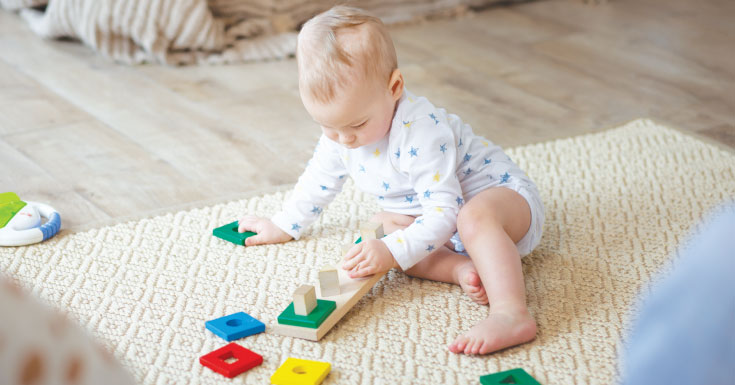We all excel in different areas of life, some of us more creatively inclined and others more academically inclined. Decision making, critical thinking, and behavioural skills are often determined by which side of the brain is stronger. Additionally, both personality characteristics and learning styles can be affected by brain dominance. When it comes to children, their more dominant brain plays a significant role in their early learning experience.

There are two sides to our brain: the left side and the right side. Left-brain-dominant children tend to perform better academically. It is easier for them to plan, structure and concentrate on projects. Conversely, right-brained learners tend to be more creative, spontaneous, emotionally intelligent, and intuitive. Right-brained children also learn differently. To memorise information, right-brained learners need to create connections, patterns, and logic. A right-brained child has a good memory for whole concepts but might have difficulty breaking them down into specific points unless they can visualise them. As a result, right-brain learners may struggle with absorbing information at school.
10 Characteristics of Right-Brain Learners
- Think intuitively and respond well to open-ended activities.
- Employ a common-sense approach to problems.
- Remember faces rather than names
- Make subjective statements.
- Are spontaneous, impulsive, flexible, and creative.
- Solve problems through synthesis.
- Express themselves candidly.
- Prefer essay tests
- Lack a strong sense of time and structure.
- Tend to see “the big picture.”
Source: Dr Antonio Maurice Daniels, Research Associate in Education, University of Wisconsin-Madison
Taking these characteristics into consideration, education and learning techniques for right-brained children would require a different and creative approach. Parents can still help their right-brained kids learn effectively by identifying their unique brain characteristics early on and using appropriate learning techniques.
Reading Strategies
Right-brained children learn words and letters better with visualisation rather than by memory. Start with helping them recognise words and sounds. This would create a strong foundation for their reading skills. Below are some effective methods to try:
- Sounds and stories: You can start by introducing sounds. Using stories and visuals will help you introduce them effectively. All sounds should be displayed from the start. Practice each sound one at a time. You should use stories, body movements, and images to teach the sounds rather than chanting or memorisation.
- Appealing materials: Ensure the child is reading material that interests them. Those who are right-brained dominant need to find meaning in what they do. Otherwise, they have difficulty following a set of steps or following through a process if they do not understand why it’s important. Thus, go for stories or books with a strong plot and details to facilitate clear visualisation and meaning.
- Picture-oriented teaching: Teach reading with pictures. Right-brain oriented children, who see the world holistically and intuitively rather than in parts, benefit from phonics programs that incorporate visual images in the reading materials. It’s a good idea to write the name of the word on top of a picture or incorporate the written text of the word into the picture. For example, a stick figure person sitting down on a chair can represent the words “chair” and “sit”.
- Colourful presentation: Using colours can also help your right-brained child remember words better. To teach specific phonics sounds, colour the letters differently from the rest of the word. Using this method will tap into the visual nature of right-brained students and enhance their retention of phonics sounds.
- Vocabulary via visuals: Use pictures to build vocabulary. Children with a right-brain orientation learn to read through pictures. An excellent way to help them increase their vocabulary is to create word pictures in their minds. Some ideas include:
• Using pictures of different vocabulary words (particularly items they care about) in notebooks, and put the name of each item beneath the picture
• Labelling items around the house
• Reading picture dictionaries
• Drawing pictures for different vocabulary words
Math Learning Tips
Most standard math curricula today cater to the left-brain learner – they are sequential, detailed, repetitive, and often presented using plain or black and white text. Thus, it’s little wonder why right-brain dominant children often struggle with math. You can try the following suggestions, which are aimed at imaginative children who respond well to pictures, colours, and big-picture concepts.
- Big picture learning: Teach math as whole concepts instead of individual processes. Repeating and reviewing many math processes in each lesson is often ineffective for right-brained students as they tend to learn conceptually rather than in a linear sequence.
- Use visual guides: Show how math problems are done instead of verbally explaining them. Children often respond to visual learning when explanations are not clear to them. Use graphic pictures and diagrams to explain math concepts. Draw diagrams as you teach and encourage the child to do the same.
- Find patterns: Teach your child how to find patterns in math. You can use charts to show the relationship between numbers.
- Make math colourful: Right-brained learners love colours, so utilise different tones and hues to your advantage. Instead of just writing numbers in black, you can use colourful highlighters to indicate what is added or subtracted.
Using Both Sides of the Brain
While it’s helpful to use an approach that addresses the dominant side of your child’s brain, you should never overemphasise either side. Always aim for balance by encouraging whole-brain learning. This way, they can learn to utilise both logical and creative thinking when they need to resolve a problem.
In the case of a right-brained child, teach him logical and analytical thinking skills. On the other hand, a left-brained child should start using images and visualisations for learning and cultivate creative hobbies like drawing or more activities that use physical movements like dancing.



